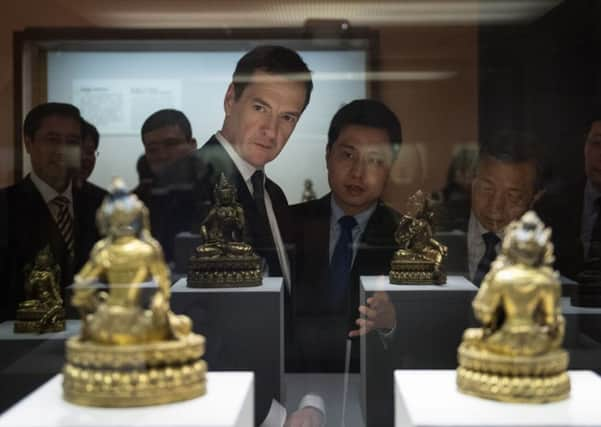UK sends art treasures to China to build bridges


And a further £3m is to be spent on boosting Chinese tourism to the UK and encouraging high-spending visitors to venture beyond London to cultural attractions such as Wordsworth’s Lake District and Bronte Country in Yorkshire.
The initiative was announced by George Osborne during a week-long visit to the east Asian economic giant designed to boost bilateral trade and kickstart what the Chancellor hopes will be “a golden decade of UK-China relations”.
Advertisement
Hide AdAdvertisement
Hide AdHighlights of the cultural programme include bringing the British Museum’s blockbuster exhibition A History of the World in 100 Objects to China for the first time, backed by £750,000 of state funding.
Some £1.6m will allow the British Library to mount exhibitions over the next four years featuring handwritten manuscripts and early editions of works from authors ranging from Shakespeare to Jane Austen and Sherlock Holmes creator Sir Arthur Conan Doyle.
The Tate’s Landscapes of the Mind show of 100 artworks from 300 years of British landscape painting – including Hockney’s Bigger Trees Near Warter – will be presented in China, backed by £1.3m of state funding.
Some £740,000 will support a tour of the recent Shakespeare’s Globe production of The Merchant of Venice and train Chinese arts organisations for commemorations next year of the 400th anniversary of the Bard’s death. This follows last year’s investment of £1.5 million to enable the translation of all Shakespeare’s works into Mandarin.
And £300,000 will support the Victoria & Albert Museum’s creation of a new English-Mandarin database of pre-1900 Chinese cultural and literary sources.
Meanwhile, £500,000 will go towards a Royal Opera House training programme for Chinese students and £250,000 to developing the National Theatre’s Chinese tour of First World War drama War Horse – famous for its lifelike animal puppets – which opened in Beijing earlier this month.
In London, some £500,000 over the next three years will be put into a new Love China Festival at the Southbank Centre.
A further £700,000 is being spent on encouraging Chinese tourists to visit the north of England as part of the Chancellor’s Northern Powerhouse initiative to boost the economy of the region, while £1.3m will fund a VisitBritain campaign to highlight cultural tourism opportunities in the UK.
Advertisement
Hide AdAdvertisement
Hide AdSpeaking at Beijing’s National Theatre, where he joined Vice Premier Ma Kai to watch excerpts of Mandarin-language productions of War Horse and Richard III, Mr Osborne said: “Britain’s world-class cultural institutions, education and brands are internationally renowned and respected and a key element of our global economic and political influence.
“That’s why I’ve ensured that Government funding will continue to support some of our greatest museums, galleries and theatre companies, including the British Museum, Tate, Shakespeare’s Globe and the Royal Shakespeare Company, to boost their profile in China.
“As we enter a golden decade of UK-China relations, reinforcing cultural links is vital and will also support the UK economy through promoting trade and tourism between our two great nations.”
The Chancellor was joined by British Museum director Neil MacGregor, who said the export of the “100 Objects” exhibition was the latest example of a “long and happy friendship” between his institution and the National Museum of China.
China is expected to become one of the UK’s fastest-growing tourism markets, with visits more than doubling over the past five years from 89,000 in 2009 to 185,000 in 2014. Chinese visitors spend an average of £2,600 – four times more than the average traveller.